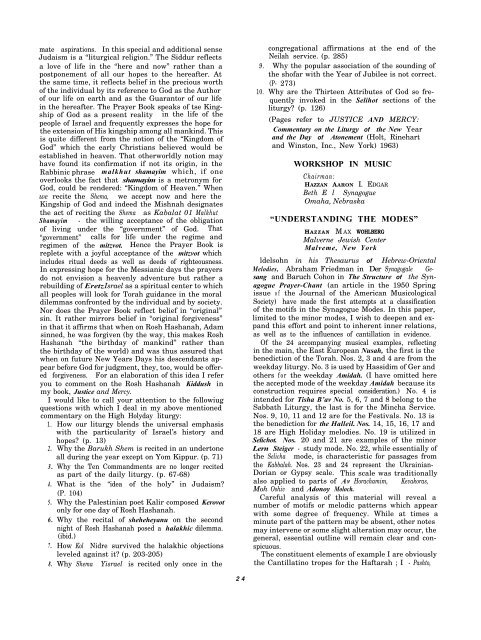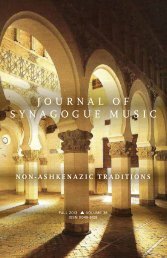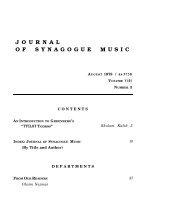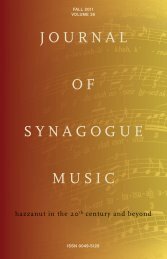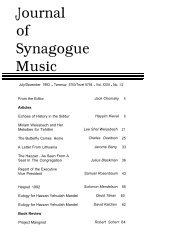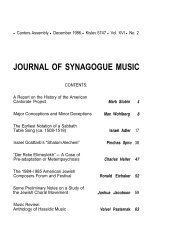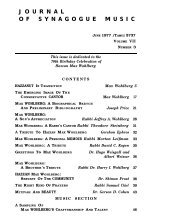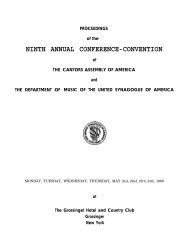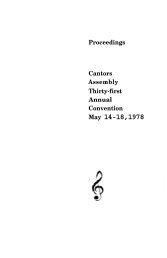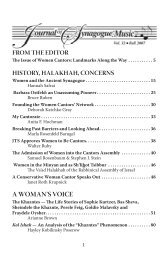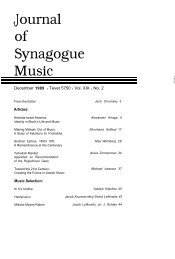1964 Proceedings - Cantors Assembly
1964 Proceedings - Cantors Assembly
1964 Proceedings - Cantors Assembly
Create successful ePaper yourself
Turn your PDF publications into a flip-book with our unique Google optimized e-Paper software.
mate aspirations. In this special and additional sense<br />
Judaism is a “liturgical religion.” The Siddur reflects<br />
a love of life in the “here and now” rather than a<br />
postponement of all our hopes to the hereafter. At<br />
the same time, it reflects belief in the precious worth<br />
of the individual by its reference to God as the Author<br />
of our life on earth and as the Guarantor of our life<br />
in the hereafter. The Prayer Book speaks of tse Kingship<br />
of God as a present reality in the life of the<br />
people of Israel and frequently expresses the hope for<br />
the extension of His kingship among all mankind. This<br />
is quite different from the notion of the “Kingdom of<br />
God” which the early Christians believed would be<br />
established in heaven. That otherworldly notion may<br />
have found its confirmation if not its origin, in the<br />
Rabbinic phrase malkhut shamayim which, if one<br />
overlooks the fact that shamayim is a metronym for<br />
God, could be rendered: “Kingdom of Heaven.” When<br />
we recite the Shema, we accept now and here the<br />
Kingship of God and indeed the Mishnah designates<br />
the act of reciting the Shema as Kabalat 01 Malkhut<br />
Shamayim - the willing acceptance of the obligation<br />
of living under the “government” of God. That<br />
“government” calls for life under the regime and<br />
regimen of the mitzvot. Hence the Prayer Book is<br />
replete with a joyful acceptance of the mitzvot which<br />
includes ritual deeds as well as deeds of righteousness.<br />
In expressing hope for the Messianic days the prayers<br />
do not envision a heavenly adventure but rather a<br />
rebuilding of Eretz Israel as a spiritual center to which<br />
all peoples will look for Torah guidance in the moral<br />
dilemmas confronted by the individual and by society.<br />
Nor does the Prayer Book reflect belief in “original”<br />
sin. It rather mirrors belief in “original forgiveness”<br />
in that it affirms that when on Rosh Hashanah, Adam<br />
sinned, he was forgiven (by the way, this makes Rosh<br />
Hashanah “the birthday of mankind” rather than<br />
the birthday of the world) and was thus assured that<br />
when on future New Years Days his descendants appear<br />
before God for judgment, they, too, would be offered<br />
forgiveness. For an elaboration of this idea I refer<br />
you to comment on the Rosh Hashanah Kiddush in<br />
my book, Justice and Mercy.<br />
I would like to call your attention to the followiug<br />
questions with which I deal in my above mentioned<br />
commentary on the High Holyday liturgy:<br />
1. How our liturgy blends the universal emphasis<br />
with the particularity of Israel’s history and<br />
hopes? (p. 13)<br />
2. Why the Barukh Shem is recited in an undertone<br />
all during the year except on Yom Kippur. (p. 71)<br />
3. Why the Ten Commandments are no longer recited<br />
as part of the daily liturgy. (p. 67-68)<br />
4. What is the<br />
(P. 104)<br />
“idea of the holy” in Judaism?<br />
5. Why the Palestinian poet Kalir composed Kerovot<br />
only for one day of Rosh Hashanah.<br />
6. Why the recital of sheheheyanu on the second<br />
night of Rosh Hashanah posed a halakhic dilemma.<br />
(ibid.)<br />
7. How Kol Nidre survived the halakhic objections<br />
leveled against it? (p. 203-205)<br />
8. Why Shema Yisrael is recited only once in the<br />
24<br />
9.<br />
10.<br />
congregational affirmations at the end of the<br />
Neilah service. (p. 285)<br />
Why the popular association of the sounding of<br />
the shofar with the Year of Jubilee is not correct.<br />
(P- 273)<br />
Why are the Thirteen Attributes of God so frequently<br />
invoked in the Selihot sections of the<br />
liturgy? (p. 126)<br />
(Pages refer to JUSTICE AND MERCY:<br />
Commentary on the Liturgy of the New Year<br />
and the Day of Atonement (Holt, Rinehart<br />
and Winston, Inc., New York) 1963)<br />
WORKSHOP IN MUSIC<br />
Chairman:<br />
HAZZAN AARON I. EDGAR<br />
Beth E l Synagogue<br />
Omaha, Nebraska<br />
“UNDERSTANDING THE MODES”<br />
HAZZAN M AX WOHLBERG<br />
Malverne Jewish Center<br />
Malveme, New York<br />
ldelsohn in his Thesaurus of Hebrew-Oriental<br />
Melodies, Abraham Friedman in Der Synagogale Gesang<br />
and Baruch Cohon in The Structure of the Synagogue<br />
Prayer-Chant (an article in the 1950 Spring<br />
issue of the Journal of the American Musicological<br />
Society) have made the first attempts at a classification<br />
of the motifs in the Synagogue Modes. In this paper,<br />
limited to the minor modes, I wish to deepen and expand<br />
this effort and point to inherent inner relations,<br />
as well as to the influences of cantillation in evidence.<br />
Of the 24 accompanying musical examples, reflecting<br />
in the main, the East European Nusah, the first is the<br />
benediction of the Torah. Nos. 2, 3 and 4 are from the<br />
weekday liturgy. No. 3 is used by Hassidim of Ger and<br />
others for the weekday Amidah. (I have omitted here<br />
the accepted mode of the weekday Amidah because its<br />
construction requires special consideration.) No. 4 is<br />
intended for Tisha B’av No. 5, 6, 7 and 8 belong to the<br />
Sabbath Liturgy, the last is for the Mincha Service.<br />
Nos. 9, 10, 11 and 12 are for the Festivals. No. 13 is<br />
the benediction for the Halleil. Nos. 14, 15, 16, 17 and<br />
18 are High Holiday melodies. No. 19 is utilized in<br />
Selichot. Nos. 20 and 21 are examples of the minor<br />
Lern Steiger - study mode. No. 22, while essentially of<br />
the Selicha mode, is characteristic for passages from<br />
the Kabbalah. Nos. 23 and 24 represent the Ukrainian-<br />
Dorian or Gypsy scale. This scale was traditionally<br />
also applied to parts of Av Horachamim, Kevakoras,<br />
Moh Oshiv and Adonoy Moloch.<br />
Careful analysis of this material will reveal a<br />
number of motifs or melodic patterns which appear<br />
with some degree of frequency. While at times a<br />
minute part of the pattern may be absent, other notes<br />
may intervene or some slight alteration may occur, the<br />
general, essential outline will remain clear and conspicuous.<br />
The constituent elements of example I are obviously<br />
the Cantillatino tropes for the Haftarah ; I - Pashto,


